Abstract
In rural areas with higher agricultural energy consumption, ensuring low-carbon transformation and rapid penetration is crucial; therefore, the importance of rural energy system in energy transformation is even more prominent. In order to better understand the research progress of rural integrated energy system, the existing structure of rural energy system and design method are briefly introduced, and the bibliometric method is applied to analyze publications from 2013 to 2023. Based on the Scopus database, 915 publications have been retrieved. These publications are analyzed from the perspective of citation, author, address, and published journal. It is concluded that existing researches mostly use conventional energy technologies to achieve power supply in rural areas, lacking analysis of the potential application of emerging energy technologies and research on multi-energy demand. Furthermore, the review reveals the economy of grid-connected rural energy system is mainly related to geographical location, system configuration, and resource endowment. The bibliometric analysis indicated that these publications are mainly from India and China; the average citation is 24.98, and each article is co-published by 3.66 authors, 2.26 institutes, and 1.46 countries. This work is helpful for scholars to understand the research status on the rural integrated energy system.
1. Introduction
The high frequency of extreme weather has sounded an alarm for the sustainable development of human society. At present, almost all countries in the world recognize the importance of mitigating global warming, and achieving carbon neutrality has become a global consensus. Essentially, the key of achieving carbon neutrality is to reduce carbon emissions, which requires changing the energy structure dominated by traditional fossil energy sources and developing renewable energy sources. With the rapid growth of energy consumption in rural areas, the energy transition of rural areas has become more crucial [1]. According to the statistic of China Energy Statistics Yearbook, 41.48% of China’s rural population use high-carbon energy sources such as direct straw combustion, direct fuelwood combustion and coal, accounting for 79.3% of rural domestic energy use [2]. Therefore, there are issues such as irrational energy consumption structure and lower utilization efficiency of clean energy in rural areas. Moreover, the rural energy consumption structure needs to be optimized urgently by building a green and high-efficient energy system, which is of great significance to the development of rural economy [3].
Given the special geographic location and ecological environment of rural areas, rural areas are potential for the development of renewable energy. On the one hand, rural areas with abundant spatial resources are rich in wasteland, rooftops, and other vacant land resources, thus becoming a priority area for the development of solar and wind energy [4]. On the other hand, biomass is mainly distributed in rural areas, indicating an important resource advantage for rural areas [5]. The integrated energy system can effectively utilize renewable energy and fossil fuels to realize the complementary coordination between heterogeneous energy subsystems, help to eliminate the shortcomings of the traditional single-energy utilization system, and meet the diversified energy demand to improve environmental pollution and energy utilization efficiency [6]. Therefore, it is crucial to promote the development of integrated energy systems in rural areas.
Nowadays, some researchers have reviewed the development of integrated energy systems, for example, Kang et al. [7] clarified the definition, characteristics, and technical boundaries of integrated energy systems from the development history and evaluation criteria. Song et al. [8] comprehensively reviewed the modeling methods, operation optimization, and modeling tools of integrated energy systems from 2000 to 2022 based on the CiteSpaceV5.8.R3. He et al. [9] summarized the development status of off-grid integrated energy systems over the past five years in terms of the system structure, operation strategy, and evaluation indices. Modu et al. [10] discussed the existing optimization methods for operation strategies of integrated energy systems with hydrogen storage. Alabi et al. [11] summarized the key issues of integrated energy system in detail, including modeling methods and the application of machine learning to the energy system. In addition, for different application scenarios, Ma et al. [12] summarized the typical physical framework of data center integrated energy systems and provided an overview of domestic and international research considering energy uncertainty, load forecasting, dynamic modeling, optimal scheduling strategies, and benefit evaluation. Fang et al. [13] reviewed the typical structure of port integrated energy systems from the perspectives of typical functional zoning, emission policies, and regulations.
However, existing research lacks a comprehensive overview for the rural integrated energy system, which is unable to accurately reveal the research status of rural energy systems. Therefore, this paper first reviewed the existing structure of rural energy system, then summarized the optimization issues emphasized in the existing research. On this basis, this paper innovatively employs bibliometric analysis to summarize the development progress of rural integrated energy systems. The paper is structured as follows. In Section 2, the system structure is briefly introduced. In Section 3, the methods of system design are discussed. Section 4 illustrated the methods and results of bibliometric analysis, followed by the conclusions in Section 5.
2. System Structure
Due to the applied energy source, energy conversion technology and load demand, there exists different structures of rural integrated energy system. On the one hand, based on the difference load demand of rural areas, the integrated energy system involves the supply of electricity, cooling, heating, and hydrogen. Electricity is an indispensable infrastructure for the development of modern society, and the supply of electricity in rural areas plays a crucial role in promoting farmers’ production activities, improving rural living conditions, and achieving rural planning goals. Furthermore, the heating and cooling supply can meet the seasonal load needs of residents and improve living standards. With the continuous advancement of clean energy transformation, hydrogen supply is helpful to achieve carbon reduction in the transportation sector of rural areas. On the other hand, considering the location of rural areas and economy of energy system, existing studies mainly focus on the grid-connected and off-grid energy systems. This section briefly discusses the schematic of existing system construction from the perspective of grid-connected and off-grid, to better understand the development process of rural energy systems.
2.1. Off-Grid Energy System
In order to the ensure the power supply in rural areas, Li et al. [14] analyzed the techno-economic feasibility of off-grid hybrid power system for a remote village in West China. The system configuration is shown in Figure 1. The study fully utilizes the local resource endowment (solar, wind, and biomass) to ensure electric supply, while the total cost is selected as an optimized objective to determine the optimal configuration of the system. Based on the optimization results, the authors further compared the off-grid system and grid extension. The results indicated that the off-grid system shows better economy and environmental friendliness. Furthermore, hydrogen as an alternative fuel for transportation sector decarbonizing is helpful for the guarantee of transportation demand of rural area. The authors [15] proposed the integrated energy system to supply electricity and hydrogen for rural areas. The schematic of the system is shown in Figure 2. The hydrogen production and storage system comprise the electrolyzer and hydrogen storage tank. The effects of hydrogen load demand on the techno-economic performance are comprehensively analyzed. The results indicated that with the increase in hydrogen load demand, the system capacity increases, in order to increase the total cost. However, compared with the grid extension (increase from 16.15 km to 73.16 km), the off-grid energy system is shown to be more economical. This study fully demonstrates that due to the enormous distances of this village, the economy of electrification by the power grid is not advantageous.
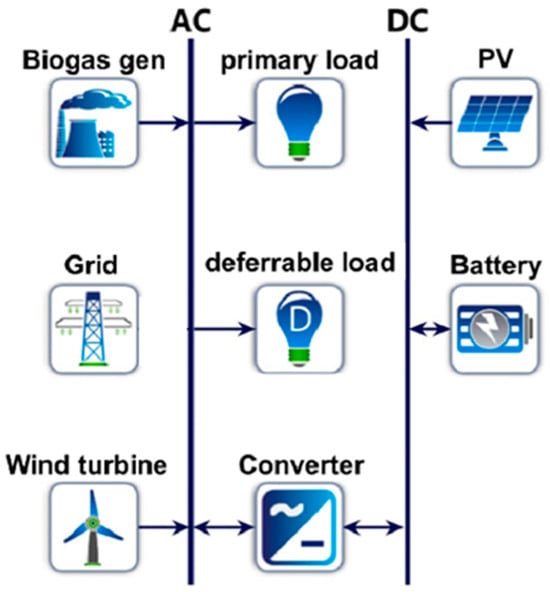
Figure 1.
The schematic of the off-grid energy system in rural area [14].
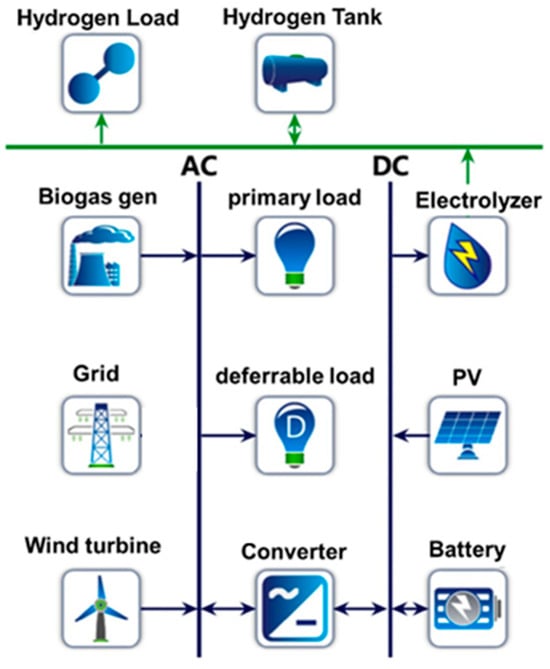
Figure 2.
The schematic of the energy system with hydrogen supply in rural area [15].
Furthermore, Mamaghani et al. [16] studied the application potential of off-grid PV-WT-DG power system in different climatic characteristics. The optimal objective includes the economic indicator and environmental index, and the results indicated that the hybrid PV-DG system is the most economic selection, but the difficulty in fuel transportation should be considered. Mulumba et al. [17] analyzed the thermo-economic performance of the PV-WT-battery-flywheel hybrid energy system in rural area, and optimized the configuration based on the minimum cost and maximum reliability. Compared with the conventional energy conversion and storage technology, the applied hybrid energy storage can further ensure the stability of energy supply. Hermann et al. [18] conducted the energy system design for five rural communities in Africa. The considered conversion technology includes PV, WT, DG, and hydro generator. The results indicated that the there are differences in the optimal system configuration for different rural regions. This is mainly due to the difference in resource endowment and economic parameters. Ngouleu et al. [19] designed six rural integrated energy systems to supply power, and applied different optimization algorithms to minimize the cost. The considered forms of system combination include PV-WT-fuel cell, PV-WT-battery, PV-battery, WT-battery, PV-fuel cell, and WT-fuel cell. The results reported that the configuration of PV-WT-battery is more reliable and economic. Mousavi et al. [20] analyzed the performance off-grid hybrid energy system (PV-WT-battery-biogas generator) in different conditions. The energy efficiency, techno-economic, and environment are considered to determine the optimal capacity. However, there are differences in the system structure in different studies. Table 1 lists the typical configurations of off-grid energy system for rural areas in recent years.

Table 1.
The typical configurations of off-grid energy system for rural areas.
2.2. Grid-Connected Energy System
Apart from the off-grid energy system, the grid-connected system has received widespread attention from researchers. When the load demand exceeds the output of the village energy system, the system can purchase electricity from the grid, whereas when the output exceeds the load demand, the system can sell electricity back to the grid. This connected type achieves the bidirectional feedback between the integrated energy system and the grid.
Rajbongshi et al. [27] innovatively employs biomass gasifiers in rural grid-connected energy systems that comprise the PV, biomass gasifier, DG, and battery. Compared with the off-grid system, the proposed grid-connected system needs lower costs. And the results demonstrated that the application of biomass gasification in the grid-connected system shows more advantages than the PV. Besides the electric supply, some studies have analyzed the system of multi-energy demand in rural areas. Zhang et al. [28] developed the hybrid solar-biomass system to meet the demand of power and heating for rural areas. The system configuration is illustrated in Figure 3. The corresponding indexes of environment, economy, and energy efficiency are selected as the objective function. The optimization results showed that the system has higher environmental benefits and lower economic impact. Thus, the large-scale application and promotion of the system depends on the support of policies. Ju et al. [29] developed a rural integrated energy system to convert straw, garbage, and other rural biomass waste resources to energy. The system structure of biogas-based rural energy system is shown in Figure 4. The electric demand is provided by WT, PV, hydropower, pyrolysis power generation and grid; the heating load is provided by the heating output of heat pump, pyrolysis process and heating network; the gas load is mainly from biogas to gas. Zhang et al. [30] proposed the energy system combined with the pumped storage and wind power to meet the water and electricity needs of rural areas. The electric output is mainly from pumped storage turbine, wind power, and grid. It was found that the application of pumped storage can reduce the uncertainty of wind power and realize the integrated management of water and electricity. Yu et al. [31] proposed a grid-connected WT-PV-bio-generator energy system to provide biogas and electricity for rural areas. In the system, the electric heating can increase the fermentation temperature of biogas, thereby converting electrical energy into biomass energy for storage, while biogas can be generated through cogeneration units to achieve coupling of multiple energy flows. The study found that a 3% to 9% reduction in investment costs resulted in a 127% to 240% increase in annualized returns. Kasaeian et al. [32] analyzed the feasibility of grid-connected hybrid PV-DG-biogas system under different economic conditions. The analysis revealed that the cost of system is optimal for a scenario with a discount rate of 18%, an inflation rate of 10%, and a diesel price of 0.1 dollar/L.
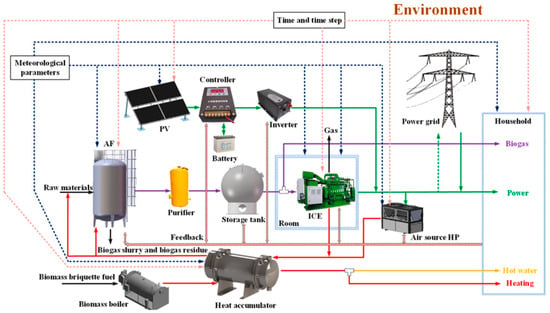
Figure 3.
The schematic of integrated energy system in rural area [28].
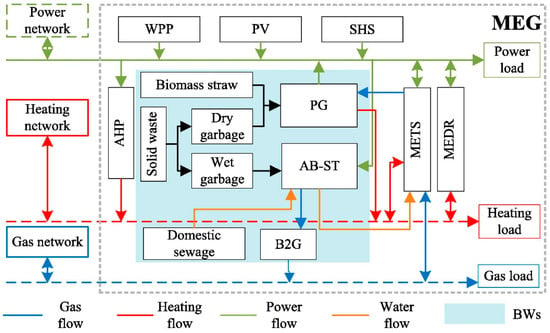
Figure 4.
The schematic of integrated energy system with waste conversion [29].
Considering the differences in the geographical location of different villages, the economics and feasibility of off-grid and grid-connected hybrid systems were compared. As for a village in India, Odou et al. [33] analyzed the techno-economic feasibility of an integrated energy system in a rural community far from the grid, and it was found that the off-grid PV-DG-battery system shows better economic and environmental performance than either a stand-alone DG or a grid-connected hybrid system. Mousavi et al. [34] compared the feasibility of grid extension, off-grid, and grid-connected energy systems in five remote villages. The results showed that the off-grid hybrid energy system is the most cost-effective option. Demirci et al. [35] investigated and compared the techno-economic performance of rural energy system with grid extension, on-grid, and off-grid. The study indicated that the potential for the application of renewable energy systems varies depending on breakeven distance for grid extension, which is between 0 and 25 km. In order to identify the optimal configuration of the rural energy system, the typical studies on the grid-connected rural energy system in recent years are summarized in Table 2. Furthermore, the comparative results for grid-connected and off-grid energy systems are presented in Table 2.

Table 2.
The typical studies of grid-connected energy system for rural areas.
Overall, for the existing configuration study of rural integrated energy system, the commonly used renewable energy conversion technologies are PV and WT, lacking the feasibility analysis for emerging energy utilization technologies such as geothermal energy. The tradition conversion technology DG has been widely applied in research on rural energy systems, but the transportation of fuel and environmental pollution should be considered. Furthermore, in terms of energy storage technology, existing research mostly uses batteries. In the future, the application and complementation of multi-energy storage should be considered. In addition, most of the research focuses on the rural area’s electricity supply, which cannot meet future energy diversification needs. Thus, it is necessary to conduct research on rural integrated energy systems with multi-energy demand. Furthermore, existing studies have different conclusions about the economics and environmental friendliness of off-grid and on-grid forms of rural energy systems. Therefore, it is important to clarify in which application scenarios off-grid and on-grid systems are advantageous.
3. Method of System Design
Usually, the system optimization design includes three parts: firstly, the corresponding mathematical models are established based on the operating principles of each equipment, in which a variety of possible energy utilization, conversion, and storage technologies can be considered. Secondly, the corresponding parameters (meteorological data, renewable resource availability, load demand, economic and technical data) and constraints (resource availability, supply–demand balance, technical constraints of unit operation and carbon emission constraints) are inputted into the model. Finally, the optimization objective (single-objective, multi-objective) and algorithm are determined. Based on the optimization, the system operating strategy and optimal system configuration are obtained. The modeling framework is presented in Figure 5. However, in the process of optimization, the operating strategy of existing researches is mainly divided into two categories: rule-based method and optimization method. Thus, this section presents the design methods employed in the existing research separately.
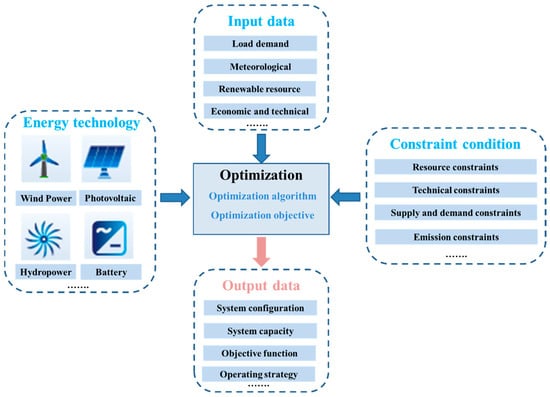
Figure 5.
The model framework of energy system design optimization.
3.1. Rule-Based Method
The rule-based method refers to the system optimized based on the predetermined operational strategies to guide the system design. Among these, the output sequence of the equipment components is fixed. For example, Roy et al. [39] analyzed the performance of a fuel cell storage-based energy system to supply electricity and freshwater to an off-grid rural area. The comprehensive operating strategy is shown in Figure 6, in which the system operates according to the established rules. When there is excess output power from renewable energy sources, the demand of reverse osmosis desalination plant is prioritized and then used in the electrolysis process to produce hydrogen for storage; when there is insufficient power supply, the discharge of the fuel cell is prioritized and then compensated by the biomass gasifier to ensure supply and demand balance. Belboul et al. [40] designed the system operating strategy to analyze the system capacity configuration and performance. The considered energy management methods are as follows: when the output energy from PV and WT is not enough to meet the load demand, batteries and DG are used in turn to supply electricity; when the power supply is in excess, battery energy storage is used. Suman et al. [41] investigated the feasibility of a hybrid PV-WT-bio-generator-DG-battery system applied in rural areas. When the output of PV, WT, and bio-generator mismatch the load demand, the order of priority of power supply is determined based on the battery and diesel generator. Guven et al. [42] investigated the performance of rural hybrid PV-biomass gasifier-hydrogen energy system employing the rule-based operating strategy. The considered operating strategy lists are as follows: when the power generated by wind and solar is sufficient to meet the energy needs of the load, and the hydrogen storage tanks are available, then the excess energy is used to generate hydrogen and is stored in the tanks; if the tanks are full, then electricity can be employed to recharge the batteries or to irrigate the pumping station. If the renewably generated energy is less than the load demand, the hydrogen from the storage tanks is preferentially converted to electricity, and then generated through the biogas digester.
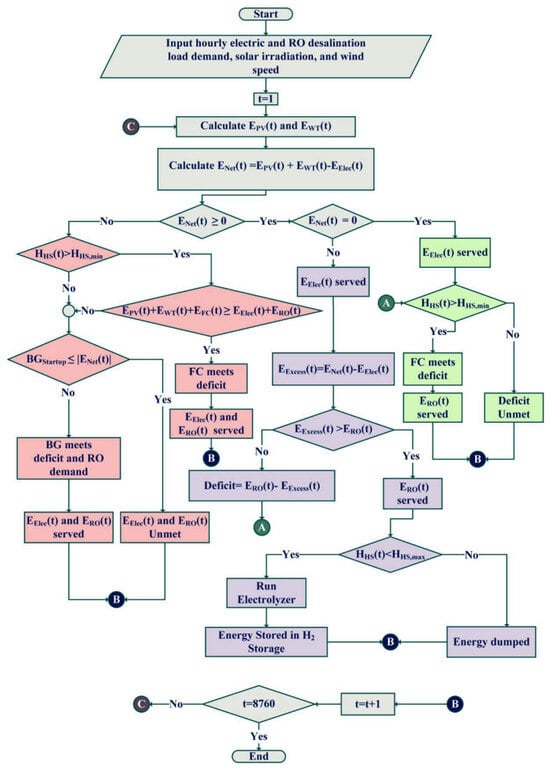
Figure 6.
The operating strategy of the hybrid energy system [39].
However, the results obtained by the rule-based method are not always optimal to achieve the optimal value under this specific working condition. The specific operating strategy limits the possibility of combining various components of the system; thus, the system always operates according to the predetermined rules.
3.2. Optimization Method
In contrast to the rule-based method, the optimization method can achieve the real-time management according to the boundary conditions, constraints, and optimization objective. In the optimization process, the combination and output sequence of various devices in the system are continuously optimized and updated, which is different from the rule-based method. Nowadays, most researches employed the optimization method to determine the system operating strategy. However, the optimization results are related to many factors, such as uncertainty, optimization algorithm, and objective.
The operation of rural integrated energy system is influenced by multiple uncertainties, such as load demand, renewable energy output, energy price, and technical parameters. The load demand is affected by the irregular energy use of rural residents, and the uncertainty in energy prices depends on geopolitics, energy markets, and trade policies. As the proportion of renewable energy sources in the system increases, the uncertainty of renewable energy supply also stands out. Conventional generating units can provide electricity in a stable manner; however, renewable energy output (wind and photovoltaic) is vulnerable to weather factors. The climate system is subject to multidimensional and multiscale variability, and the interactions between climate and energy system are complex. Therefore, it is challenging to quantify the impact of weather on renewable energy output. Furthermore, the uncertainty of technical parameters includes cost and operating efficiency under different conditions. Thus, some researches have considered these factors to further analyze system operating strategies. Luo et al. [43] took full account of the different energy use patterns in different rural areas to analyze system characteristics, and provided a comprehensive operating strategy to different regions based on multi-objective optimization. Zhu et al. [44] developed an optimal scheduling strategy with energy pricing policies, and applied it to a rural PV-battery-electric vehicle system. The optimization results proved the effectiveness of the proposed strategy. Rodriguez et al. [45] designed a fuzzy-based energy management method to analyze a rural integrated energy system, comprising the PV, DG, and battery. It was reported that the total operating cost and the electricity wasted by photovoltaic are decreased by 12.4% and 6.19%. Charafeddine et al. [46] developed the novel demand–supply side energy management strategy and compared the results with the operating strategy considering supply-side management. The results showed that the energy demand and cost are reduced by 7% and 18%, respectively. Due to the uncertainty of the weather, the rural area may encounter extreme events, which results in the rural energy system to suffer severe damage; thus, the renewable energy system may shut down. Shao et al. [24] proposed a risk-constrained approach to study the optimization of off-grid energy systems with the synergistic integration of multiple energy sources, to achieve an economically resilient energy supply for rural communities. The results showed that the operation of system has great potential for achieving carbon neutrality and 100% renewable energy supply. At the same time, a reasonable balance is achieved between the economic, reliable, and flexible operating strategy.
Due to the fact that different optimization methods exhibit different performances, the selection will affect the operating strategy of the integrated energy system. Therefore, researchers employed different optimization methods to solve the operating strategy model. The commonly used optimization methods include heuristic algorithm and mathematical programming. Furthermore, the software tool (HOMER) is employed to solve optimization problems, which is solved using hybrid optimization methods. Table 3 summarizes recent studies in the optimization of operating strategies for rural energy systems that have employed different optimization methods and objectives.
For heuristic algorithms, Kamal et al. [47] employed the Moth Flame algorithm to solve the optimization model of a rural energy system comprising the WT-PV-DG-battery, and compared it with the traditional genetic algorithm and particle swarm algorithm. The results of the study showed that the operating cost optimized by the Moth Flame algorithm is 18% and 16% lower than the genetic algorithm and particle swarm algorithm, respectively. Saha et al. [48] discussed the operating strategy of the rural energy system comprising the PV-biomass-battery and the applied optimization algorithms include the discrete gray wolf optimization algorithm, simulated annealing, particle swarm optimization, and genetic algorithm. It was found that the operating strategy optimized by the discrete gray wolf optimization algorithm needs the least cost. Mustafa Kamal et al. [49] developed a hybrid PV-DG-biogas generator-WT-battery energy system to satisfy the load demand of a village in India, and compared the optimization results of differential evolution with HOMER, particle swarm optimization algorithm, and genetic algorithm. It was obtained that the net present cost is reduced by 3.34%, 5.5%, and 7% compared to the cost of HOMER, particle swarm optimization algorithm, and genetic algorithm, respectively. Mahmoud et al. [50] employed different optimization algorithms to obtain the optimal operating strategy of the PV-WT-DG-battery system. The operating results indicated that the improved gray wolf algorithm shows the best performance. On the other hand, Ruiz et al. [51] developed a mixed-integer programming model to analyze the optimization of PV-WT-DG-battery-hydro-pumped storage system. The results showed that the consideration of electric vehicles helps to overcome the dependence on fossil fuels. Mahdavi et al. [52] proposed a mixed-integer linear programming model to study the feasibility of biomass, wind, and solar in rural area. It was found that the hybrid energy system shows better economy and environmental friendliness than the operating wind turbines alone or other hybrid power generation scenarios. Benalcazar et al. [53] analyzed the operating strategy of PV-WT-DG-battery system based on the linear programming method. The solar subsystem supplies power during the day, with most of the excess energy stored in the batteries and discharged from the batteries or powered by a diesel generator when the supply is insufficient.

Table 3.
The common optimization methods employed in the recent study.
Table 3.
The common optimization methods employed in the recent study.
| Ref. | Optimization Methods | Employed Algorithm | Objective |
|---|---|---|---|
| Kamal [47] | Heuristic algorithm | Moth Flame Algorithm Genetic Algorithm Particle Swarm Algorithm | Net present cost |
| Saha [48] | Heuristic algorithm | Discrete Gray Wolf Optimization Simulated Annealing Particle Swarm Algorithm Genetic Algorithm | Net present cost |
| Mustafa Kamal [49] | Hybrid Optimization Heuristic algorithm | HOMER Particle Swarm Algorithm Genetic Algorithm | Net present cost Cost of energy Life cycle emission cost |
| Mahmoud [50] | Heuristic algorithm | Salp Swarm Algorithm Gray Wolf Algorithm Improved Gray Wolf Algorithm | Cost of energy |
| Abd El-Sattar [54] | Heuristic algorithm | Seagull Optimization Algorithm Slime Mould Algorithm Gray Wolf Optimizer Whale Optimization Algorithm Sine Cosine Algorithm | Energy cost |
| Mahdavi [52] | Mathematical programming | Mixed-Integer Linear Programming | Total cost |
| Weckesser [55] | Mathematical programming | Linear Programming | Total cost |
| Ahmed [56] | Mathematical programming | Mixed-Integer Linear Programming | Net present cost |
| Benalcazar [53] | Mathematical programming | Linear Programming | Total life cycle cost |
| Ruiz [51] | Mathematical programming | Mixed-Integer Programming | Total cost Total emissions |
From the above literature, it can be seen that researchers have conducted extensive studies on rural integrated energy systems with different operational strategies. However, most of the studies employed the rule-based operation strategy, which does not yield optimal system operation results. In contrast, the optimization-based method, which determines the operation strategy, can ensure that the system operates under an optimal strategy through real-time scheduling. However, the operating optimization involves the influence of factors such as supply and demand response, other uncertainty, and is related to the chosen optimization algorithm. Therefore, in future research, the determination of system operation strategy should fully consider these factors in order to achieve more realistic operation results.
4. Bibliometric Analysis
In order to conduct the bibliometric analysis for the rural integrated energy system, the selected database and retrieval method are listed. Then, the research method, evaluation index, and results of bibliometric analysis used in this study are demonstrated.
4.1. Data Source and Retrieval Method
To comprehensively analyze the research trends on the rural integrated energy system, relevant publications are collected from the Scopus database due to its broad coverage, global content, immediate updates, and multi-analysis tools [57]. In the process of data retrieval, we searched in the title, abstract, or keyword fields for the following words: “energy system” AND “village” OR “rural” OR “countryside”. The type of publication is limited to “Article” only, and the study period started from 2019 to 2023. The obtained data are further filtered to remove irrelevant publications, with 915 articles obtained for the bibliometric analysis. The data search deadline is 30 June 2023.
4.2. Evaluation Index
Based on BibExcel 2016 and CiteSpace 6.2, the collected publications on the rural integrated energy system are bibliometrically analyzed from various aspects. The productive author, productive institute, and hot article are used to qualitatively measure the research output of different organizations [58]. The productive author and institute are the author and institute with at least five publications, and the hot article is the publication with no less than 60 citations. The C5-index, h-index, and impact factor (IF) are also used to assess the quality of publications for countries, authors, and institutes. Among these, the C5-index denotes the paper with more than five citations [59]. For the h-index, it indicates that the organization has h publications with at least h citations [60]. The IF is a quantitative indicator of a journal’s impact, indicating the average number of citations per paper in a journal. In this paper, the IF is determined by the Journal Citation Reports of 2022 [61]. Moreover, the average citation (AC) and average impact factor (AIF) are used to analyze the research quality, while the AC and AIF represent the average citation and impact factor for each publication. Furthermore, the collaboration degree is defined to describe the collaboration between authors, institutions, and countries of different articles [62]. The calculation method is as follows:
where Dx is the collaboration degree, xp denotes the number of authors, institutions, or countries per publication, and n is the total number of publications.
4.3. Results of Bibliometric Analysis
In this section, a comprehensive bibliometric analysis is performed on 915 publications in the field of rural integrated energy systems from several perspectives, including annual publication and citations, the distribution of country, journal and institute, author and article, collaboration.
4.3.1. Annual Publication and Citation
The level of annual publications reflects the overall development process of rural integrated energy system during this period. Figure 7 shows the annual number of publications from 2013 to 2023. The number of published articles increases from 2014 to 2022, and it should be noted that the number of publications during 2019~2023 accounts for 74% of the total, indicating that the interest in this topic research is increasing in recent years. This may be because, with the increasing attention paid to rural areas and technical updates in recent years, some technical bottlenecks in rural integrated energy systems have been gradually solved. After 2022, the number of publications decreases from 194 in 2022 to 135 in 2023, which is due to the fact that the data search deadline for this study is 30 June 2023. Nevertheless, the relevant publications in this research field in 2023 still deserve attention. On the other hand, the total citations of relevant publications based on the Scopus database are obtained. From 2013 to 2023, the number of total citations is 22,864. The annual citation is also shown in Figure 7. The most cited publications appear in 2019, followed by 2020 and 2018. This corresponds to the analysis of the publication number during this period. From 2013 to 2019, the publication citation shows an upward trend, with a slight decrease in 2017. However, since 2020, the publication citation shows a significant decrease. This phenomenon can be explained by the fact that the citation is also closely related to the year of publication; the time interval between the published date and statistical date is relatively short. The trends of publication and citation show that the rural integrated energy system has received increasing academic attention, and this topic has academic value and practical significance.
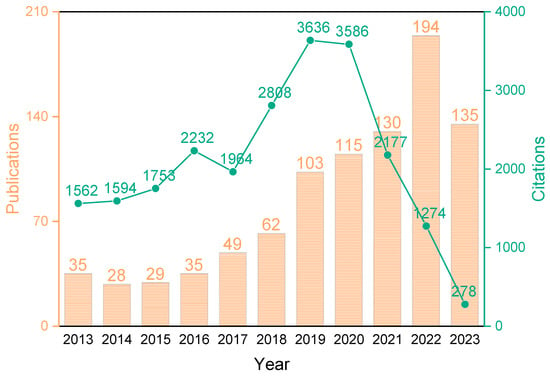
Figure 7.
The trends of publications and citations from 2013 to 2023.
4.3.2. Country Distribution
Based on CiteSpace, the cooperation network between countries is shown in Figure 8. Each node represents a country, and the node size denotes the published number. The larger the node size, the more publications there are in this country. Furthermore, the link indicates the cooperation between two countries. The wider link represents the closer cooperation between two countries. From Figure 8, there are 102 nodes and 889 links in the cooperation network (with a density of 0.1726), indicating that these publications are from 102 countries and have strong connections with each other. It can be concluded that the country distribution is relatively wide and covers various parts of the world. In terms of the number of publications, the leading country is India (206), followed by China (169) and Iran (62). Afterwards, the outer purple circle of the node represents centrality. The larger the circle, the higher the country’s centrality in this research field. It can be seen from Figure 8 that the highest centrality (0.23) belongs to the United Kingdom, followed by China (0.20) and India (0.18). This indicates that these three countries have engaged in extensive cooperation with other countries in the field of rural integrated energy systems.
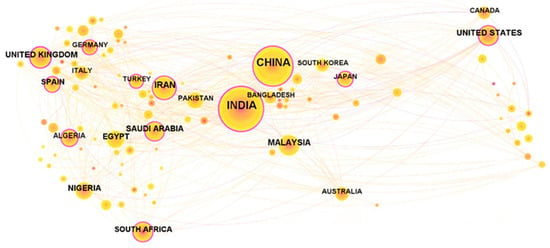
Figure 8.
The cooperation network among countries in the field of rural integrated energy system.
In addition, Figure 9 describes the country cooperation per publication from 2013 to 2023. From the figure, it can be seen that most publications are completed by one or two countries alone, accounting for 64.04% and 24.59% of the total publications, respectively. The number of articles co-published by six countries is the lowest, with only four articles, representing 0.44% of the total number of publications [63,64,65,66]. Furthermore, the number of articles co-published by 3~5 countries is 67, 23, and 10. It is worth noting that articles co-published by five countries are all from 2019 to 2023.
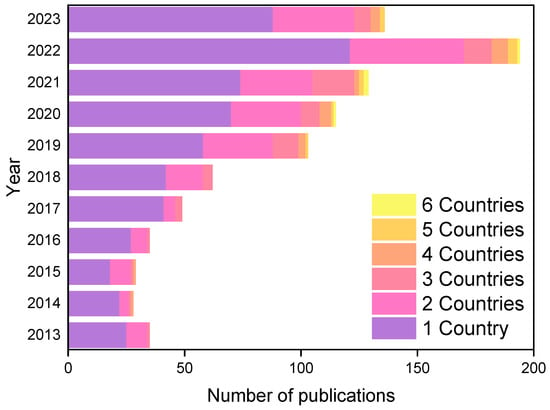
Figure 9.
The country cooperation per publication in the field of rural integrated energy system.
To illustrate the level of publication by country, Table 4 lists the top 10 countries of publication. The total number of articles published by the top 10 countries accounts for 82.4% of the total. Among these, five Asian countries, two European countries, two African countries, and one North American country are included. The countries with more than 10% of publications are India with 22.51% and China with 18.47%. Although the citation and h-index of India rank first, the top three countries with AC are Malaysia (42.93), the United Kingdom (34.06), and Iran (34.05). In addition, the country with the highest number of publications, India, has the highest number of productive authors, with an average of 6.7 articles per author. However, in terms of productive institutions, China is in the first place (15), followed by India (14) and Egypt (9). For hot articles, the top three countries are from India, Iran, and Malaysia. It is worth noting that the citation of hot articles in Malaysia is higher than in Iran, indicating that the hot articles published by Malaysia are of more interest to scholars than those by Iran. In addition, Table 4 reveals that the United Kingdom has the highest AIF (6.88), which proves that most of the articles from the United Kingdom are published in journals with higher IF. Notably, China has higher publication number, h-index, and AIF, but it has the lowest AC of 14.12. This is because 68.64% of articles on rural integrated energy systems are published in 2021–2023.

Table 4.
Top 10 countries of rural integrated energy system publications from 2013 to 2023.
4.3.3. Institute Distribution
The studied 915 publications are from 160 institutes, with the productive institutes accounting for half of the total. The top 10 institutes of publications are presented in Table 5. The total number of publications from these 10 institutes is 157, which is 17.16% of the total. University of Tehran from Iran ranks first with 26 articles, although the number of hot articles ranks first with Universiti of Malaya, whereas the citation of hot articles, AC, h index, and AI ranks second in the top 10 countries. The citation of hot articles for Universiti of Malaya with 1435 is far more than other institutes. Meanwhile, the citation of 13 published papers leads with an average of 115.46 citations, indicating that the published articles are widely recognized by academics. As shown in Table 5, the Indian Institute of Technology has four productive authors, followed by University of Tehran (3) and Tsinghua University (3). Furthermore, for the third ranked institute, North China Electric Power University, has the lowest citation (170) and highest AIF.

Table 5.
Top 10 institutes of rural integrated energy system publications from 2013 to 2023.
Figure 10 displays the collaboration between institutions per publication from 2013 to 2023. Herein, 31.25% of articles are jointly published by two institutes, followed by 30.38% of the publications completed by one institute and 18.69% of the publications completed by three institutes. For the publications with 4~6 institutes in collaboration, the proportions are 9.18%, 6.01%, and 2.73%, respectively. The least collaborative method is the publication finished by seven or more institutions in collaboration, with the proportion being only 1.75%. During the period of 2013~2019, there were no articles jointly published by seven or more institutions. Since 2020, there are two, four, eight, and two papers jointly completed by seven or more institutions, respectively.
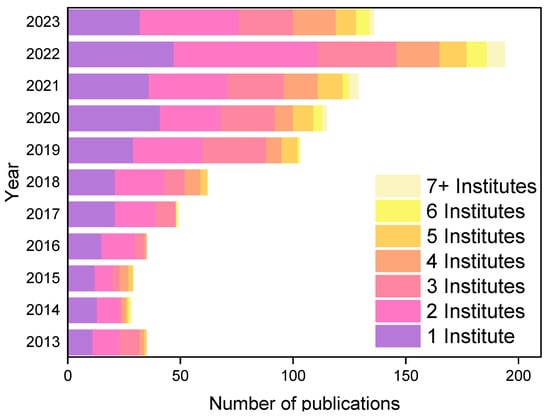
Figure 10.
The institute cooperation per publication in the field of rural integrated energy system.
4.3.4. Author Analysis
From 2013 to 2023, the number of productive authors with at least five publications is 31. However, among them, 24 authors published five or six articles. Furthermore, there are 12 authors who have published five articles. Therefore, Table 6 only shows authors with at least seven publications, namely, the top seven productive authors of publications on the rural integrated energy system. From Table 6, it can be noted that four authors are from India, two authors are from Iran, and one author is from Spain. It is interesting to note that the four productive authors from India belonged to two institutions (Aligarh Muslim University and Indian Institute of Technology Roorkee). The authors with the highest number of publications among these seven authors had an extremely low citation and AIF. Conversely, Saini R.P. [67] with seven publications has the highest citations (443) and AC (63.29). In addition, Saini R.P. has four hot articles, with a total citation count of 385, which is even far more than the citation count of the top six authors in terms of number of publications. Overall, the h-index of seven productive authors is not less than five. Kasaeian A.B. [68] from Iran has the highest IF of 66.2 and an AIF of 9.46, which is much higher than the AIF of the other six authors.

Table 6.
Top seven productive authors of rural integrated energy system publications from 2013 to 2023.
In addition to the analysis of productive authors, this section illustrates the cooperation of authors per publication from 2013 to 2023, as shown in Figure 11. Herein, 25.79% of articles are cooperated by three authors, followed by 20.11% of papers completed by four authors, and 18.03% of papers published by two authors. It can be concluded that most articles are published by 2~4 authors, reaching 63.93% of the total publications. In addition, only 22 articles have one author, representing 2.40% of the total papers. For example, in 2023, Alzahrani A. [73] analyzed the optimal design and performance of rural integrated energy system based on HOMER pro and MATLAB/Simulink. Huseyin Coban H. [74] studied the feasibility of hydro-wind-solar-battery hybrid system located in Somalia. Afterwards, the number of papers jointly completed by five authors, six authors, and seven or more authors is 126, 98, and 84, respectively, accounting for 13.77%, 10.71%, and 9.18% of total publications. From 2013 to 2023, in terms of research on rural integrated energy systems, there are no papers co-published by seven or more authors in 2013, no papers co-published by five authors in 2014, no papers jointly completed by six authors in 2016, and no papers published by only one author in 2022.
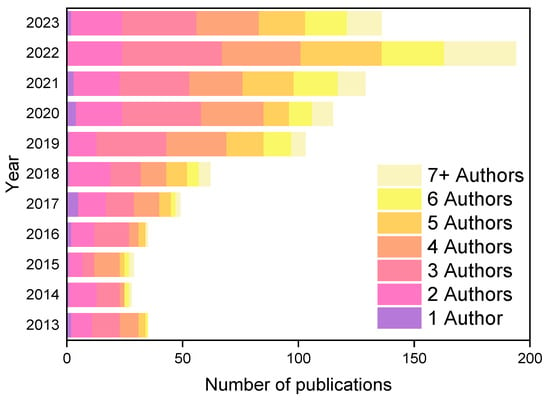
Figure 11.
The author cooperation per publication in the field of rural integrated energy system.
4.3.5. Collaboration Analysis
Based on the above analysis of countries, institutions and authors, this section describes the collaboration differences in detail. The collaboration degree is calculated by Equation (1), where the lower collaboration degree represents less cooperation between different authors, institutions, and countries. Figure 12 provides the trends of the cooperation degree of authors, institutions, and countries over time, in sequence from left to right. It is clear from the figure that the degree of cooperation between authors is the highest, followed by cooperation between institutions, and finally transnational cooperation. This is mainly due to the fact that cooperation between different authors or institutions can be easily achieved within a country, while cooperation between transnationals can be relatively difficult. However, it can be demonstrated that although the cooperation degree fluctuates during 2013~2023, the degree of collaboration between authors increases from 3.11 to 4.14, the degree of collaboration between institutions will increase from 2.14 to 2.67, and the degree of collaboration within countries will increase from 1.31 to 1.51. Based on the average degree of cooperation, it can be concluded that each article on the rural integrated energy system is co-published by 3.66 authors, 2.26 institutes, and 1.46 countries.

Figure 12.
The collaboration degrees of author, institute, and country from 2013 to 2023.
4.3.6. Journal Distribution
The journal distribution of publications is helpful for researchers to pre-research and submit in the field of rural integrated energy system. Table 7 lists the top 10 journals according to the publication number, and the publications account for 41.09% of the total. It can be seen from the table that the journal Energies has the highest number of publications (69), accounting for 7.54%. However, the citation frequency and publication quality are relatively low, and the IF is 3.2. Subsequently, Energy and Renewable Energy rank second and third place in terms of the number of publications. Renewable energy has the highest citation frequency of 3543, with a citation frequency of 70.86 per publication. In addition, Energy ranks second in terms of citation frequency, with an average citation frequency of 56.75. The h-index and IF of Energy are slightly higher than those of Renewable Energy. This indicates that these two journals have a high influence and an important role in the field of rural integrated energy systems. In addition, although the number of papers published by Applied Energy and Journal of Cleaner Production is relatively few, their citation frequency and IF are at the top of the field, suggesting that the research papers published by these journals have an important academic value and guiding significance. Energy Conversion and Management, with a higher IF (10.4), published 45 papers and is cited 48.78 times per paper. It is important to note that the IF of International Journal of Renewable Energy Research is one, but the numbers of publications and h-index are competitive. Overall, in order to gain a comprehensive understanding of the research trends in a field, researchers need to pay attention not only to the IF of a journal, but also to the research direction of the journal.

Table 7.
Top 10 journals of rural integrated energy system publications from 2013 to 2023.
4.3.7. Highly Cited Papers Analysis
Highly cited papers represent an influential scholarship in this field and attract more attention from researchers. These highly cited papers usually make significant contributions to existing research methods and theories. Therefore, analyzing highly cited papers can provide new ideas for research, as well as give valuable perspectives on the development trend in a particular field. Table 8 shows the top 10 cited articles from 2013 to 2023; the authors, published year, journal, and total citations are also listed. The citation of 10 highly cited articles accounts for 16.98% of the total citations. It can be seen that the 10 articles were all published between 2013 and 2019. Besides the article published by Merei et al. [75] in the Solar Energy, the other nine articles are all published in the top 10 journals and are listed in Section 4.3.6.
As listed in Table 8, these studies mainly focus on the design of system structure and optimization of operation strategies. In these papers, representative studies on the system configuration were conducted by Sen et al. [76]. The authors optimized the technology combination of integrated energy system in a remote village based on pre- and post-HOMER analysis. The considered energy technology includes micro-hydro, PV, WT, and bio-diesel. This paper was published in 2014 and has the highest citation counts in this field from 2013 to 2023, with 447 citations. The fourth to tenth most cited papers explored the application of integrated rural energy systems with different system layouts. For example, Adefarati et al. [77] conducted six case studies to assess the reliability, economic, and environmental impact of energy systems. Mandal et al. [78] optimized the system configuration of rural off-grid energy system, and compared the performance with the solar home system and grid-connected system. Halabi et al. [79] studied and compared the performance of energy system in actual operating (already built) and proposed conditions (optimal design). Merei et al. [75] optimized the configuration of renewable energy system with different battery technologies. Based on HOMER, Mamaghani et al. [16] comprehensively analyzed different configurations of off-grid energy system in three rural areas. Ismail et al. [80] conducted an optimal design for a village energy system and compared the system performance with a scenario using only PV or diesel generation (DG). Shahzad et al. [81] conducted an optimized design for the hybrid PV-biomass energy system for the farm and rural community. In addition, the operating strategies of rural energy systems have become a mainstream research field. Singh et al. [82] employed different optimal methods (artificial bee colony algorithm, HOMER, and particle swarm optimization algorithm) to analyze the performance of WT-PV-biomass-battery systems, in order to supply electricity to a village located in India. Nwulu et al. [83] analyzed the energy management of the rural energy system considering demand response. These two papers ranked second and third in the citations, respectively. This is a good indication that researchers are concerned with analyzing the different factors that affect the system’s operational strategy.

Table 8.
Top 10 cited articles of rural integrated energy system publications from 2013 to 2023.
Table 8.
Top 10 cited articles of rural integrated energy system publications from 2013 to 2023.
| Article | Authors | Year | Journal | Citations |
|---|---|---|---|---|
| Off-grid electricity generation with renewable energy technologies in India: An application of HOMER | Sen et al. [76] | 2014 | Renewable Energy | 447 |
| Feasibility study of an islanded microgrid in rural area consisting of PV, wind, biomass, and battery energy storage system | Singh et al. [82] | 2016 | Energy Conversion and Management | 315 |
| Optimal dispatch for a microgrid incorporating renewables and demand response | Nwulu et al. [83] | 2017 | Renewable Energy | 279 |
| Reliability, economic and environmental analysis of a microgrid system in the presence of renewable energy resources | Adefarati et al. [77] | 2019 | Applied Energy | 268 |
| Optimum sizing of a stand-alone hybrid energy system for rural electrification in Bangladesh | Mandal et al. [78] | 2018 | Journal of Cleaner Production | 263 |
| Performance analysis of hybrid PV/diesel/battery system using HOMER: A case study Sabah, Malaysia | Halabi et al. [79] | 2017 | Energy Conversion and Management | 260 |
| Optimization of an off-grid hybrid PV-Wind-Diesel system with different battery technologies using genetic algorithm | Merei et al. [75] | 2013 | Solar Energy | 255 |
| Techno-economic feasibility of photovoltaic, wind, diesel, and hybrid electrification systems for off-grid rural electrification in Colombia | Mamaghani et al. [16] | 2016 | Renewable Energy | 254 |
| Techno-economic analysis of an optimized photovoltaic and diesel generator hybrid power system for remote houses in a tropical climate | Ismail et al. [80] | 2013 | Energy Conversion and Management | 253 |
| Techno-economic feasibility analysis of a solar-biomass off grid system for the electrification of remote rural areas in Pakistan using HOMER software | Shahzad et al. [81] | 2017 | Renewable Energy | 248 |
4.3.8. Co-Word Analysis
Co-word analysis is a bibliometric technique that evaluates the frequency and co-occurrence of keywords in a collection of documents. The keywords reflect the topic of publications, and it is important for readers to identify the research content. The analysis of co-word is useful in revealing the themes and directions of research in a particular field. Considering that the core meaning of the keywords was the same in different studies; however, there were differences in expression and the obtained keywords were categorized according to the core meaning. For example, merging “renewable energy” and “renewable energy sources” as “renewable energy”. Table 9 lists the top 10 keywords by frequency. The most frequently used keyword is “rural areas”, followed by “renewable energy” and “costs”. The use of “rural areas” in the keywords will help readers to determine the topics. The keywords “renewable energy”, “solar energy”, and “solar power generation” indicate that the existing studies emphasize the utilization of renewable energy, especially solar energy. And the keyword “hybrid energy systems” indicates that the rural energy system comprises several energy sources and utilization technologies. Furthermore, according to the keywords “costs”, “economic analysis”, “sensitivity analysis”, and “optimization”, it can be concluded that the existing researches focus on economic analysis and system optimization. Moreover, “rural electrification” indicates that the energy supply in rural areas is concentrated on electricity. Based on CiteSpace, there are 231 nodes and 3595 links in the cooperation network of keywords (with a density of 0.1353). In order to distinguish the keywords in the figure, the keywords with a frequency of more than 80 are shown in Figure 13, while other nodes are not shown in this figure. The centrality of the top 10 keywords is also provided in Table 9. The keywords “renewable energy”, “costs”, and “hybrid energy system” have higher centrality, which indicates that most publications focus on the economic analysis of hybrid integrated energy systems, and the rural hybrid energy system pays much attention to the development and utilization of renewable energy. As shown in Figure 13, the utilization of wind and biomass, and energy storage technology are research hotspots. Furthermore, several studies focusing on electricity supply in multiple rural areas have examined the scheduling and grid transmission relationships between multiple rural energy systems and electric utilities. Overall, the keywords relate to the following areas: resources available in rural areas (renewable energy, such as solar energy, biomass, wind, alternative energy), energy technology options (solar power generation, wind power, diesel engines, photovoltaic cells, electric battery), system performance (costs, investments, and economic analysis), and optimization analysis (HOMER).

Table 9.
Top 10 keywords on the rural integrated energy system.
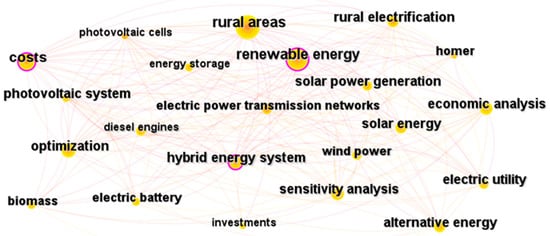
Figure 13.
The cooperation network among keywords.
5. Conclusions
This paper provides a review of the current status of rural integrated energy systems from the perspective of system structure, system design method, and bibliometric analysis. The existing research on rural integrated energy systems is summarized from off-grid and grid-connected forms. The system design methods of existing research are introduced from rule-based and optimization. Furthermore, based on the Scopus database, the relevant publications from 2013 to 2023 are analyzed using BibExcel and CiteSpace. The main findings are as follows:
Most studies employ conventional renewable energy conversion and storage technologies, such as photovoltaics, wind power and storage batteries, and lack systematic feasibility analyses of emerging energy utilization technologies for geothermal energy, and multiple forms of energy storage. In addition, most of the existing studies have analyzed the rural electricity supply system, which is difficult to meet the future multi-energy demand in rural areas. Furthermore, existing studies have different conclusions about the economics and environmental friendliness of off-grid and on-grid forms of rural energy systems. Therefore, it is important to clarify in which application scenarios off-grid and on-grid systems are advantageous. However, the system design is mostly based on the rule-based method, which is unable to produce an optimal system structure under all operating conditions. Considering that the system operating strategy involves the influence of various uncertainties, these factors should be fully considered in future studies to obtain a more realistic configuration.
According to the results of bibliometric analysis, 915 articles are retrieved as of 30 June 2023. India tops the list in terms of number of publications, followed by China. University of Tehran from Iran published the most articles on rural integrated energy systems. Furthermore, 45.9% of the papers are co-published by 3~4 authors, 61.64% are co-authored by 1~2 institutions, and 88.63% are co-authored by 1~2 countries. The most productive journal is Energies, followed by Energy and Renewable Energy.
Supplementary Materials
The following supporting information can be downloaded at: https://www.mdpi.com/article/10.3390/pr12010176/s1.
Author Contributions
Writing—original draft preparation, methodology, A.Y.; Writing—review and editing, Z.L.; Conceptualisation, writing—review and editing, supervision, P.L. All authors have read and agreed to the published version of the manuscript.
Funding
This research was funded by National Key Research and Development of China (2023YFC3807201), and the Phase IV Collab-oration between BP and Tsinghua University.
Data Availability Statement
The original datasets presented in the study are included in the article/Supplementary Material.
Acknowledgments
The authors gratefully acknowledge the support by the National Key Research and Development of China (2023YFC3807201), and the Phase IV Collaboration between BP and Tsinghua University.
Conflicts of Interest
The authors declare no conflicts of interest.
References
- Naumann, M.; Rudolph, D. Conceptualizing rural energy transitions: Energizing rural studies, ruralizing energy research. J. Rural Stud. 2020, 73, 97–104. [Google Scholar] [CrossRef]
- Hu, H.Z. China Energy Statistical Yearbook 2022; China Statistics Press: Beijing, China, 2023. [Google Scholar]
- Zhang, X.X.; Xu, K.L.; He, M.G.; Wang, J.F. A Review on the Rural Household Energy in China from 1990s-Transition, Regional Heterogeneity, Emissions, Energy-Saving, and Policy. Front. Energy Res. 2022, 10, 907803. [Google Scholar] [CrossRef]
- Yang, X.P.; Zhang, D.C.; Jia, Q.Q.; Zhang, W.T.; Wang, T.Y. Exploring the Dynamic Coupling Relationship between Agricultural Economy and Agro-Ecological Environment in Semi-Arid Areas: A Case Study of Yulin, China. Sustainability 2019, 11, 2259. [Google Scholar] [CrossRef]
- Roldan, C.S.; Giraldo, G.A.M.; Santana, E.L. Sustainable Development in Rural Territories within the Last Decade: A Review of the State of the Art. Heliyon 2023, 9, e17555. [Google Scholar] [CrossRef] [PubMed]
- Stennikov, V.; Barakhtenko, E.; Sokolov, D.; Zhou, B. Current state of research on the energy management and expansion planning of integrated energy systems. Energy Rep. 2022, 8, 10025–10036. [Google Scholar] [CrossRef]
- Kang, L.G.; Wu, X.J.; Yuan, X.X.; Wang, Y.Z. Performance indices review of the current integrated energy system: From history and projects in China. Sustain. Energy Technol. Assess. 2022, 53, 102785. [Google Scholar] [CrossRef]
- Song, D.R.; Meng, W.Q.; Dong, M.; Yang, J.; Wang, J.L.; Chen, X.J.; Huang, L.S. A critical survey of integrated energy system: Summaries, methodologies and analysis. Energy Convers. Manag. 2022, 266, 115863. [Google Scholar] [CrossRef]
- He, Y.; Guo, S.; Dong, P.X.; Zhang, Y.; Huang, J.; Zhou, J.X. A state-of-the-art review and bibliometric analysis on the sizing optimization of off-grid hybrid renewable energy systems. Renew. Sustain. Energy Rev. 2023, 183, 113476. [Google Scholar] [CrossRef]
- Modu, B.; Abdullah, M.P.; Bukar, A.L.; Hamza, M.F. A systematic review of hybrid renewable energy systems with hydrogen storage: Sizing, optimization, and energy management strategy. Int. J. Hydrogen Energy 2023, 48, 38354–38373. [Google Scholar] [CrossRef]
- Alabi, T.M.; Aghimien, E.I.; Agbajor, F.D.; Yang, Z.Y.; Lu, L.; Adeoye, A.R.; Gopaluni, B. A review on the integrated optimization techniques and machine learning approaches for modeling, prediction, and decision making on integrated energy systems. Renew. Energy 2022, 194, 822–849. [Google Scholar] [CrossRef]
- Ma, X.Y.; Mu, Y.F.; Li, S.R.; Jiang, X.Y.; Li, H.; Chen, C.J. Review on the optimal operation of integrated energy system in data center. Electr. Power Constr. 2022, 43, 1–13. [Google Scholar]
- Fang, S.D.; Zhao, C.H.; Ding, Z.H.; Zhang, S.X.; Liao, R.J. Port integrated energy systems toward carbon neutrality (Part 1): Typic topology and key problems. Proc. CSEE 2023, 43, 114–135. [Google Scholar]
- Li, J.Z.; Liu, P.; Li, Z. Optimal design and techno-economic analysis of a solar-wind-biomass off-grid hybrid power system for remote rural electrification: A case study of west China. Energy 2020, 208, 118387. [Google Scholar] [CrossRef]
- Li, J.Z.; Liu, P.; Li, Z. Optimal design and techno-economic analysis of a hybrid renewable energy system for off-grid power supply and hydrogen production: A case study of West China. Chem. Eng. Res. Des. 2022, 177, 604–614. [Google Scholar] [CrossRef]
- Mamaghani, A.H.; Escandon, S.A.A.; Najafi, B.; Shirazi, A.; Rinaldi, F. Techno-economic feasibility of photovoltaic, wind, diesel and hybrid electrification systems for off-grid rural electrification in Colombia. Renew. Energy 2016, 97, 293–305. [Google Scholar] [CrossRef]
- Ngila Mulumba, A.; Farzaneh, H. Techno-economic analysis and dynamic power simulation of a hybrid solar-wind-battery-flywheel system for off-grid power supply in remote areas in Kenya. Energy Convers. Manag. X 2023, 18, 100381. [Google Scholar] [CrossRef]
- Hermann, T.D.; Donatien, N.; Konchou Franck Armel, T.; René, T. Techno-economic and environmental feasibility study with demand-side management of photovoltaic/wind/hydroelectricity/battery/diesel: A case study in Sub-Saharan Africa. Energy Convers. Manag. 2022, 258, 115494. [Google Scholar] [CrossRef]
- Ngouleu, W.C.A.; Koholé, Y.W.; Fohagui, F.C.V.; Tchuen, G. Techno-economic analysis and optimal sizing of a battery-based and hydrogen-based standalone photovoltaic/wind hybrid system for rural electrification in Cameroon based on meta-heuristic techniques. Energy Convers. Manag. 2023, 280, 116794. [Google Scholar] [CrossRef]
- Mousavi, S.A.; Toopshekan, A.; Mehrpooya, M.; Delpisheh, M. Comprehensive exergetic performance assessment and techno-financial optimization of off-grid hybrid renewable configurations with various dispatch strategies and solar tracking systems. Renew. Energy 2023, 210, 40–63. [Google Scholar] [CrossRef]
- Das, S.; Pradhan, S.; De, S. Multi criteria decision making for the most suitable combination of energy resources for a decentralized hybrid energy solution with green hydrogen as the storage option. Energy Convers. Manag. 2023, 285, 117028. [Google Scholar] [CrossRef]
- HassanzadehFard, H.; Tooryan, F.; Dargahi, V. Standalone hybrid system energy management optimization for remote village considering methane production from livestock manure. Int. J. Hydrogen Energy 2023, 48, 10778–10796. [Google Scholar] [CrossRef]
- Koholé, Y.W.; Wankouo Ngouleu, C.A.; Fohagui, F.C.V.; Tchuen, G. Quantitative techno-economic comparison of a photovoltaic/wind hybrid power system with different energy storage technologies for electrification of three remote areas in Cameroon using Cuckoo search algorithm. J. Energy Storage 2023, 68, 107783. [Google Scholar] [CrossRef]
- Shao, Z.T.; Cao, X.Y.; Zhai, Q.Z.; Guan, X.H. Risk-constrained planning of rural-area hydrogen-based microgrid considering multiscale and multi-energy storage systems. Appl. Energy 2023, 334, 120682. [Google Scholar] [CrossRef]
- Shahsavari, A.; Vaziri Rad, M.A.; Pourfayaz, F.; Kasaeian, A. Optimal sizing of an integrated CHP and desalination system as a polygeneration plant for supplying rural demands. Energy 2022, 258, 124820. [Google Scholar] [CrossRef]
- Zhao, P.; Xu, W.P.; Zhang, S.Q.; Wang, J.F.; Dai, Y.P. Technical feasibility assessment of a standalone photovoltaic/wind/adiabatic compressed air energy storage based hybrid energy supply system for rural mobile base station. Energy Convers. Manag. 2020, 206, 112486. [Google Scholar] [CrossRef]
- Rajbongshi, R.; Borgohain, D.; Mahapatra, S. Optimization of PV-biomass-diesel and grid base hybrid energy systems for rural electrification by using HOMER. Energy 2017, 126, 461–474. [Google Scholar] [CrossRef]
- Zhang, D.; Zhang, R.; Zhang, B.; Zheng, Y.; An, Z.J. Environment dominated evaluation modeling and collocation optimization of a distributed energy system based on solar and biomass energy. Renew. Energy 2023, 202, 1226–1240. [Google Scholar] [CrossRef]
- Ju, L.W.; Lu, X.L.; Yang, S.B.; Li, G.; Fan, W.; Pan, Y.S.; Qiao, H.T. A multi-time scale dispatching optimal model for rural biomass waste energy conversion system-based micro-energy grid considering multi-energy demand response. Appl. Energy 2022, 327, 120155. [Google Scholar] [CrossRef]
- Zhang, M.Y.; Chen, J.J.; Yang, Z.J.; Peng, K.; Zhao, Y.L.; Zhang, X.H. Stochastic day-ahead scheduling of irrigation system integrated agricultural microgrid with pumped storage and uncertain wind power. Energy 2021, 237, 121638. [Google Scholar] [CrossRef]
- Yu, F.Q.; Zhang, M.J.; Cheng, Y.; Chen, D.W.; Yang, H.Y.; Li, C.B. Optimal Sizing of Grid-Connected Wind-Solar-Biogas lnteqrated Energy System Considering Demand Response. J. Shanghai Jiaotong Univ. 2023, 57, 10. [Google Scholar]
- Kasaeian, A.; Rahdan, P.; Rad, M.A.V.; Yan, W.M. Optimal design and technical analysis of a grid-connected hybrid photovoltaic/diesel/biogas under different economic conditions: A case study. Energy Convers. Manag. 2019, 198, 111810. [Google Scholar] [CrossRef]
- Odou, O.D.T.; Bhandari, R.; Adamou, R. Hybrid off-grid renewable power system for sustainable rural electrification in Benin. Renew. Energy 2020, 145, 1266–1279. [Google Scholar] [CrossRef]
- Mousavi, S.A.; Zarchi, R.A.; Astaraei, F.R.; Ghasempour, R.; Khaninezhad, F.M. Decision-making between renewable energy configurations and grid extension to simultaneously supply electrical power and fresh water in remote villages for five different climate zones. J. Clean. Prod. 2021, 279, 123617. [Google Scholar] [CrossRef]
- Demirci, A.; Öztürk, Z.; Tercan, S.M. Decision-making between hybrid renewable energy configurations and grid extension in rural areas for different climate zones. Energy 2023, 262, 125402. [Google Scholar] [CrossRef]
- Ullah, Z.; Elkadeem, M.R.; Kotb, K.M.; Taha, I.B.M.; Wang, S. Multi-criteria decision-making model for optimal planning of on/off grid hybrid solar, wind, hydro, biomass clean electricity supply. Renew. Energy 2021, 17, 885–910. [Google Scholar] [CrossRef]
- Jain, S.; Sawle, Y. Optimization and Comparative Economic Analysis of Standalone and Grid-Connected Hybrid Renewable Energy System for Remote Location. Front. Energy Res. 2021, 9, 724162. [Google Scholar] [CrossRef]
- Jahangiri, M.; Soulouknga, M.H.; Bardei, F.K.; Shamsabadi, A.A.; Akinlabi, E.T.; Sichilalu, S.M.; Mostafaeipour, A. Techno-econo-environmental optimal operation of grid-wind-solar electricity generation with hydrogen storage system for domestic scale, case study in Chad. Int. J. Hydrogen Energy 2019, 44, 28613–28628. [Google Scholar] [CrossRef]
- Roy, D.; Hassan, R.; Das, B.K. A hybrid renewable-based solution to electricity and freshwater problems in the off-grid Sundarbans region of India: Optimum sizing and socio-enviro-economic evaluation. J. Clean. Prod. 2022, 372, 133761. [Google Scholar] [CrossRef]
- Belboul, Z.; Toual, B.; Kouzou, A.; Mokrani, L.; Bensalem, A.; Kennel, R.; Abdelrahem, M. Multiobjective Optimization of a Hybrid PV/Wind/Battery/Diesel Generator System Integrated in Microgrid: A Case Study in Djelfa, Algeria. Energies 2022, 15, 3579. [Google Scholar] [CrossRef]
- Suman, G.K.; Guerrero, J.M.; Roy, O.P. Optimisation of solar/wind/bio-generator/diesel/battery based microgrids for rural areas: A PSO-GWO approach. Sustain. Cities Soc. 2021, 67, 102723. [Google Scholar] [CrossRef]
- Güven, A.F.; Mengi, O.Ö. Assessing metaheuristic algorithms in determining dimensions of hybrid energy systems for isolated rural environments: Exploring renewable energy systems with hydrogen storage features. J. Clean. Prod. 2023, 428, 139339. [Google Scholar] [CrossRef]
- Luo, X.; Yang, Y.Z.; Liu, Y.F.; Zhao, T.L. Classification of energy use patterns and multi-objective optimal scheduling of flexible loads in rural households. Energy Build. 2023, 283, 112811. [Google Scholar] [CrossRef]
- Zhu, Z.Y.; Wang, Y.; Yuan, M.; Zhang, R.X.; Chen, Y.H.; Lou, G.Q.; Sun, Y.J. Energy saving and carbon reduction schemes for families with the household PV-BES-EV system. Energy Build. 2023, 288, 113007. [Google Scholar] [CrossRef]
- Rodriguez, M.; Arcos-Aviles, D.; Martinez, W. Fuzzy logic-based energy management for isolated microgrid using meta-heuristic optimization algorithms. Appl. Energy 2023, 335, 120771. [Google Scholar] [CrossRef]
- Mokhtara, C.; Negrou, B.; Bouferrouk, A.; Yao, Y.F.; Settou, N.; Ramadan, M. Integrated supply-demand energy management for optimal design of off-grid hybrid renewable energy systems for residential electrification in arid climates. Energy Convers. Manag. 2020, 221, 113192. [Google Scholar] [CrossRef]
- Mustafa Kamal, M.; Ashraf, I. Evaluation of a hybrid power system based on renewable and energy storage for reliable rural electrification. Renew. Energy Focus 2023, 45, 179–191. [Google Scholar] [CrossRef]
- Saha, S.; Saini, G.; Chauhan, A.; Upadhyay, S.; Madurai Elavarasan, R.; Hossain Lipu, M.S. Optimum design and techno-socio-economic analysis of a PV/biomass based hybrid energy system for a remote hilly area using discrete grey wolf optimization algorithm. Sustain. Energy Technol. Assess. 2023, 57, 103213. [Google Scholar] [CrossRef]
- Mustafa Kamal, M.; Asharaf, I.; Fernandez, E. Optimal renewable integrated rural energy planning for sustainable energy development. Sustain. Energy Technol. Assess. 2022, 53, 102581. [Google Scholar] [CrossRef]
- Mahmoud, F.S.; Diab, A.A.Z.; Ali, Z.M.; El-Sayed, A.H.M.; Alquthami, T.; Ahmed, M.; Ramadan, H.A. Optimal sizing of smart hybrid renewable energy system using different optimization algorithms. Energy Rep. 2022, 8, 4935–4956. [Google Scholar] [CrossRef]
- Ruiz, S.; Patiño, J.; Marquez-Ruiz, A.; Oviedo, J.J.E.; Duque, E.; Ortiz, P. Optimal Design of a Diesel-PV-Wind-Battery-Hydro Pumped POWER system with the Integration of Electric vehicles in a Colombian Community. Energies 2019, 12, 4542. [Google Scholar] [CrossRef]
- Mahdavi, M.; Jurado, F.; Ramos, R.A.V.; Awaafo, A. Hybrid biomass, solar and wind electricity generation in rural areas of Fez-Meknes region in Morocco considering water consumption of animals and anaerobic digester. Appl. Energy 2023, 343, 121253. [Google Scholar] [CrossRef]
- Benalcazar, P.; Suski, A.; Kaminski, J. Optimal Sizing and Scheduling of Hybrid Energy Systems: The Cases of Morona Santiago and the Galapagos Islands. Energies 2020, 13, 3933. [Google Scholar] [CrossRef]
- El-Sattar, H.A.; Sultan, H.M.; Kamel, S.; Khurshaid, T.; Rahmann, C. Optimal design of stand-alone hybrid PV/wind/biomass/battery energy storage system in Abu-Monqar, Egypt. J. Energy Storage 2021, 44, 103336. [Google Scholar] [CrossRef]
- Weckesser, T.; Dominković, D.F.; Blomgren, E.M.V.; Schledorn, A.; Madsen, H. Renewable Energy Communities: Optimal sizing and distribution grid impact of photo-voltaics and battery storage. Appl. Energy 2021, 301, 117408. [Google Scholar] [CrossRef]
- Ahmed, E.E.E.; Demirci, A.; Tercan, S.M. Optimal sizing and techno-enviro-economic feasibility assessment of solar tracker-based hybrid energy systems for rural electrification in Sudan. Renew. Energy 2023, 205, 1057–1070. [Google Scholar] [CrossRef]
- Scopus. Available online: https://www.scopus.com (accessed on 30 June 2023).
- Permana, D.I.; Rusirawan, D.; Farkas, I. A bibliometric analysis of the application of solar energy to the organic Rankine cycle. Heliyon 2022, 8, e09220. [Google Scholar] [CrossRef]
- Yu, A.F.; Su, W.; Lin, X.X.; Zhou, N.J. Recent trends of supercritical CO2 Brayton cycle: Bibliometric analysis and research review. Nucl. Eng. Technol. 2020, 53, 699–714. [Google Scholar] [CrossRef]
- Li, X.Y.; Nan, H.Y.; Jiang, H.R.; Wang, H.; Wang, C.Q. Research trends on phosphorus removal from wastewater: A review and bibliometric analysis from 2000 to 2022. J. Water Process Eng. 2023, 55, 104201. [Google Scholar] [CrossRef]
- Journal Citation Reports of 2022. Available online: https://jcr.clarivate.com (accessed on 30 June 2023).
- Imran, M.; Haglind, F.; Asim, M.; Alvi, J.Z. Recent research trends in organic Rankine cycle technology: A bibliometric approach. Renew. Sustain. Energy Rev. 2018, 81, 552–562. [Google Scholar] [CrossRef]
- Yimen, N.; Tchotang, T.; Kanmogne, A.; Idriss, I.A.; Musa, B.; Aliyu, A.; Okonkwo, E.C.; Abba, S.I.; Tata, D.; Meva’a, L.; et al. Optimal Sizing and Techno-Economic Analysis of Hybrid Renewable Energy Systems—A Case Study of a Photovoltaic/Wind/Battery/Diesel System in Fanisau, Northern Nigeria. Processes 2020, 8, 1381. [Google Scholar] [CrossRef]
- Xia, T.; Rezaei, M.; Dampage, U.; Alharbi, S.A.; Nasif, O.; Borowski, P.F.; Mohamed, M.A. Techno-Economic Assessment of a Grid-Independent Hybrid Power Plant for Co-Supplying a Remote Micro-Community with Electricity and Hydrogen. Processes 2021, 9, 1375. [Google Scholar] [CrossRef]
- Habib, H.U.R.; Waqar, A.; Junejo, A.K.; Elmorshedy, M.F.; Wang, S.R.; Buker, M.S.; Akindeji, K.T.; Kang, J.; Kim, Y.S. Optimal Planning and EMS Design of PV Based Standalone Rural Microgrids. IEEE Access 2021, 9, 32908–32930. [Google Scholar] [CrossRef]
- Habib, H.U.R.; Waqar, A.; Junejo, A.K.; Ismail, M.M.; Hossen, M.; Jahangiri, M.; Kabir, A.; Khan, S.; Kim, Y.S. Optimal Planning of Residential Microgrids Based on Multiple Demand Response Programs Using ABC Algorithm. IEEE Access 2022, 10, 116564–116626. [Google Scholar] [CrossRef]
- Ramesh, M.; Saini, R.P. Dispatch strategies based performance analysis of a hybrid renewable energy system for a remote rural area in India. J. Clean. Prod. 2020, 259, 120697. [Google Scholar] [CrossRef]
- Dadak, A.; Mehrpooya, M.; Kasaeian, A. Design and development of an innovative integrated structure for the production and storage of energy and hydrogen utilizing renewable energy. Sustain. Energy Technol. Assess. 2021, 45, 101123. [Google Scholar] [CrossRef]
- Kamal, M.M.; Ashraf, I.; Fernandez, E. Optimal sizing of standalone rural microgrid for sustainable electrification with renewable energy resources. Sustain. Cities Soc. 2023, 88, 104298. [Google Scholar] [CrossRef]
- Kamal, M.M.; Ashraf, I.; Fernandez, E. Planning and optimization of microgrid for rural electrification with integration of renewable energy resources. J. Energy Storage 2022, 52, 104782. [Google Scholar] [CrossRef]
- Kamal, M.M.; Ashraf, I.; Fernandez, E. Sustainable electrification planning of rural microgrid using renewable resources and its environmental impact assessment. Environ. Sci. Pollut. Res. 2022, 29, 86376–86399. [Google Scholar] [CrossRef]
- Maleki, A.; Filabi, Z.E.; Nazari, M.A. Techno-Economic Analysis and Optimization of an Off-Grid Hybrid Photovoltaic–Diesel–Battery System: Effect of Solar Tracker. Sustainability 2022, 14, 7296. [Google Scholar] [CrossRef]
- Alzahrani, A. Energy Management and Optimization of a Standalone Renewable Energy System in Rural Areas of the Najran Province. Sustainability 2023, 15, 8020. [Google Scholar] [CrossRef]
- Huseyin Coban, H. Assessment of Hybrid Renewable Energy System in Beledweyne city Somalia, Technical and Economical Analysis. J. Eng. Res. 2023, 11, 273–284. [Google Scholar]
- Merei, G.; Berger, C.; Sauer, D.U. Optimization of an off-grid hybrid PV-Wind-Diesel system with different battery technologies using genetic algorithm. Sol. Energy 2013, 97, 460–473. [Google Scholar] [CrossRef]
- Sen, R.; Bhattacharyya, S.C. Off-grid electricity generation with renewable energy technologies in India: An application of HOMER. Renew. Energy 2014, 62, 388–398. [Google Scholar] [CrossRef]
- Adefarati, T.; Bansal, R.C. Reliability, economic and environmental analysis of a microgrid system in the presence of renewable energy resources. Appl. Energy 2019, 236, 1089–1114. [Google Scholar] [CrossRef]
- Mandal, S.; Das, B.K.; Hoque, N. Optimum sizing of a stand-alone hybrid energy system for rural electrification in Bangladesh. J. Clean. Prod. 2018, 200, 12–27. [Google Scholar] [CrossRef]
- Halabi, L.M.; Mekhilef, S.; Olatomiwa, L.; Hazelton, J. Performance analysis of hybrid PV/diesel/battery system using HOMER: A case study Sabah, Malaysia. Energy Convers. Manag. 2017, 144, 322–339. [Google Scholar] [CrossRef]
- Ismail, M.S.; Moghavvemi, M.; Mahlia, T.M.I. Techno-economic analysis of an optimized photovoltaic and diesel generator hybrid power system for remote houses in a tropical climate. Energy Convers. Manag. 2013, 69, 163–173. [Google Scholar] [CrossRef]
- Shahzad, M.K.; Zahid, A.; Rashid, T.U.; Rehan, M.A.; Ali, M.; Ahmad, M. Techno-economic feasibility analysis of a solar-biomass off grid system for the electrification of remote rural areas in Pakistan using HOMER software. Renew. Energy 2017, 106, 264–273. [Google Scholar] [CrossRef]
- Singh, S.; Singh, M.; Kaushik, S.C. Feasibility study of an islanded microgrid in rural area consisting of PV, wind, biomass and battery energy storage system. Energy Convers. Manag. 2016, 128, 178–190. [Google Scholar] [CrossRef]
- Nwulu, N.I.L.; Xia, X.H. Optimal dispatch for a microgrid incorporating renewables and demand response. Renew. Energy 2017, 101, 16–28. [Google Scholar] [CrossRef]
Disclaimer/Publisher’s Note: The statements, opinions and data contained in all publications are solely those of the individual author(s) and contributor(s) and not of MDPI and/or the editor(s). MDPI and/or the editor(s) disclaim responsibility for any injury to people or property resulting from any ideas, methods, instructions or products referred to in the content. |
© 2024 by the authors. Licensee MDPI, Basel, Switzerland. This article is an open access article distributed under the terms and conditions of the Creative Commons Attribution (CC BY) license (https://creativecommons.org/licenses/by/4.0/).